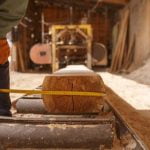Woodworking clamps are an essential tool for any woodworker, providing the necessary support and pressure to hold pieces of wood in place during various woodworking projects. From securing joints and glue-ups to holding pieces together while the adhesive dries, woodworking clamps play a crucial role in ensuring precision and accuracy in woodworking.
With a wide range of types and sizes available, there is a woodworking clamps set suitable for every task, making them a must-have for both amateur and professional woodworkers.
When it comes to choosing the right woodworking clamps set, there are several factors to consider, including the specific tasks at hand, the size and weight of the materials being worked on, and the desired level of pressure. By understanding how to select the best woodworking clamps set for different woodworking tasks, individuals can enhance their efficiency and productivity in the workshop.
Additionally, investing in quality woodworking clamps set will contribute to achieving excellent results while also ensuring durability and longevity.
In this comprehensive guide, we will explore various types of woodworking clamps, from bar clamps to pipe clamps and C-clamps. Understanding the advantages and disadvantages of each type will aid in selecting the most suitable option for specific projects. Moreover, we will delve into essential techniques for using woodworking clamps effectively – from basic applications to more advanced methods – as well as must-have accessories that complement these tools.
How to Choose the Right Woodworking Clamps Set
When it comes to woodworking, having the right tools can make a world of difference in the quality and efficiency of your projects. One essential tool that every woodworker needs in their arsenal is a woodworking clamps set.
These sets are designed to provide versatility and flexibility for a wide range of woodworking tasks, from simple crafts to complex furniture building. With numerous options available on the market, it is important to know how to choose the right woodworking clamps set for your specific needs.
When selecting a woodworking clamps set, one of the most important factors to consider is the type of woodworking projects you plan to work on. Different projects require different types and sizes of clamps.
For example, if you primarily work on smaller scale projects like jewelry boxes or picture frames, a set with small bar clamps or spring clamps may be sufficient. On the other hand, if you frequently tackle large furniture pieces or cabinetry, investing in a set with heavy-duty parallel clamps and pipe clamps would be more beneficial.
In addition to considering the types of projects you will be working on, it’s also crucial to evaluate the quality and durability of the woodworking clamps set. High-quality clamps made from durable materials such as steel or aluminum will ensure that they can withstand the rigors of regular use without bending or breaking.
Look for sets that offer smooth operation and strong gripping power, as these are indicators of a reliable product that will serve you well in your woodworking endeavors.
| Types | Projects | Quality |
|---|---|---|
| Bar Clamps | Jewelry boxes, picture frames | Durable materials such as steel or aluminum |
| Parallel Clamps | Large furniture pieces, cabinetry | Smooth operation and strong gripping power |
Types of Woodworking Clamps
When it comes to woodworking projects, having the right set of clamps is essential for achieving precision and stability. There are several types of woodworking clamps available, each designed for specific tasks and applications. The most common types of woodworking clamps include bar clamps, pipe clamps, and C-clamps.
Bar clamps are versatile and come in various sizes, making them suitable for a wide range of woodworking projects. They feature a long adjustable bar that allows for a larger clamping capacity, making them ideal for securing large pieces of wood or multiple pieces together. Pipe clamps, on the other hand, use lengths of standard metal piping to create custom-sized clamping setups. They are cost-effective and offer a longer reach compared to other types of clamps.
C-clamps, also known as G-clamps, are shaped like the letter “C” and are commonly used for holding together two pieces of wood while glue dries or for securing workpieces to a work surface. These clamps are available in various sizes and provide strong gripping power.
Each type of woodworking clamp offers its own set of advantages and disadvantages, so it’s important to consider the specific requirements of your woodworking project when choosing the right type of clamp from your woodworking clamps set.
In addition to these three main types, there are also specialty clamps such as corner clamps, edge clamps, and spring clamps that serve more specific purposes in woodworking. Understanding the different types of woodworking clamps available will help you select the best options for your projects based on their unique features and capabilities.
Essential Woodworking Clamps Techniques
Woodworking clamps are an essential tool for any woodworker, providing the necessary pressure and support to hold pieces of wood together during various woodworking projects. Whether you are working on a simple DIY project or a complex furniture piece, using the right woodworking clamps set is crucial for achieving precise and professional results.
In this section, we will explore some essential woodworking clamps techniques that will help you maximize the functionality of your woodworking clamps set and ensure successful outcomes in your projects.
Proper Alignment and Assembly
One of the key techniques when using a woodworking clamps set is to ensure proper alignment and assembly of the wood pieces. Before placing the clamps, it is important to dry-fit the pieces together to check for any gaps or misalignments.
Once satisfied with the fit, apply the clamps evenly across the joints to exert even pressure and close any gaps that may exist. This technique not only ensures a seamless assembly but also prevents any potential issues during glue-ups or joinery work.
Glue Application and Clamping Pressure
When applying glue to wood joints, it is important to use just enough adhesive to cover the surfaces without excess dripping. After applying the glue, carefully position the wood pieces together before tightening the woodworking clamps. The ideal amount of clamping pressure is crucial – too much pressure may squeeze out too much glue, while too little pressure may result in weak joints. It is recommended to use hand pressure first before tightening with the woodworking clamps to achieve optimal adhesion.
Multiple Clamping Techniques
In some woodworking projects, multiple woodworking clamps sets may be required to secure different parts of a piece simultaneously. This technique allows for efficient assembly and ensures that all components are properly aligned and held securely in place during drying or curing. Furthermore, employing various types and sizes of woodworking clamps – such as bar clamps, pipe clamps, and C-clamps – can provide versatile solutions for different project requirements.
By mastering these essential woodworking clamps techniques, woodworkers can enhance their craftsmanship and achieve superior results in their projects. Whether working on basic joinery or complex assemblies, understanding how to effectively use a woodworking clamps set is fundamental for success in various woodworking applications.
Must-Have Accessories for Woodworking Clamps
When it comes to woodworking, having the right accessories for your woodworking clamps can make a significant difference in your projects. These accessories not only enhance the functionality of your clamps set but also contribute to their longevity. Here are some must-have accessories for woodworking clamps:
- Clamp Pads: These rubber or plastic pads are designed to be attached to the jaws of your woodworking clamps, protecting delicate wood surfaces from being marred or damaged during clamping.
- Spreader Blocks: Used in conjunction with bar clamps, spreader blocks help distribute pressure evenly across the workpiece, preventing bowing or warping during glue-ups.
- Clamp Storage Solutions: Keeping your woodworking clamps organized and stored properly is essential for maintaining their condition. Investing in a clamp storage rack or system will not only keep your workspace tidy but also prevent damage to your clamps from being stacked haphazardly.
These accessories are essential for anyone looking to get the most out of their woodworking clamps set. Whether you’re a seasoned woodworker or just starting out, having these accessories on hand can greatly improve the quality and success of your projects. From protecting your workpieces to prolonging the lifespan of your clamps, these accessories are indispensable tools for any woodworker.
In addition to these must-have accessories, there are also other supplementary items that can further enhance the capabilities of your woodworking clamps set. Items such as quick-release clamping mechanisms, pressure regulators, and speciality clamp attachments are designed to provide additional features and versatility for specific woodworking tasks.
By equipping yourself with these essential and supplementary accessories, you’ll be well-prepared to tackle a wide range of woodworking projects efficiently and effectively using your woodworking clamps set.
Woodworking Clamps Maintenance and Care
Woodworking clamps are essential tools for any woodworker, and proper maintenance and care are crucial to ensure their longevity and effectiveness. Whether you have invested in a small woodworking clamps set for DIY projects or a larger set for professional use, taking care of these tools will help you achieve the best results in your woodworking projects.
Proper Cleaning Techniques
After completing a woodworking project, it is important to clean your clamps to remove any sawdust, glue residue, or other debris that may have accumulated during the process. Use a dry brush or cloth to wipe down the surfaces of the clamps and ensure that all moving parts are free from obstructions. For tougher build-up, a mild solvent or degreaser can be used, followed by wiping down with a clean cloth.
Lubrication and Rust Prevention
To keep your woodworking clamps in good working condition, it is recommended to lubricate the moving parts regularly. Apply a light coating of lubricant to the threaded rods, pivot points, or sliding components of the clamps to prevent friction and corrosion. Additionally, storing your clamps in a dry environment and using rust-inhibiting products can help prevent rust formation on metal components.
Storage Solutions
Proper storage is also an important aspect of maintaining woodworking clamps. Investing in a dedicated clamp rack or storage system can help keep your clamps organized and easily accessible while minimizing the risk of damage or misplacement. Consider utilizing clamp pads or spreader blocks when storing your clamps to prevent unnecessary pressure on the clamp jaws and maintain their shape over time.
By incorporating these maintenance techniques into your routine, you can prolong the lifespan of your woodworking clamps set and ensure that they remain reliable tools for all your future woodworking projects.
Woodworking Clamps Set Buying Guide
When it comes to woodworking, having the right tools is essential for achieving professional results. A woodworking clamps set is a crucial investment for any woodworker, as it allows for secure and precise holding of materials during various projects. With a wide range of options available on the market, choosing the best woodworking clamps set can be overwhelming. Here are some tips to help you make an informed decision when purchasing a woodworking clamps set:
1. Consider your specific needs: Before selecting a woodworking clamps set, consider the types of projects you typically work on. Different projects may require different types and sizes of clamps. For example, larger projects may require heavy-duty bar clamps, while smaller, intricate work may benefit from precision hand screw clamps.
2. Quality and durability: When investing in a woodworking clamps set, prioritize quality and durability. Look for sets made from high-quality materials such as steel or aluminum, with durable mechanisms that can withstand heavy use over time.
3. Budget-friendly options: While quality is important, it’s also essential to consider your budget when purchasing a woodworking clamps set. There are budget-friendly options available that still offer good quality and functionality.
Real-Life Applications and Projects Using Woodworking Clamps
In conclusion, woodworking clamps are an indispensable tool for any woodworker, providing the necessary support and pressure to hold pieces of wood together during a variety of projects. When it comes to choosing the right woodworking clamps set, it is important to consider the specific tasks at hand and invest in a set that meets those needs.
Whether it’s bar clamps, pipe clamps, or C-clamps, each type of woodworking clamp has its own advantages and disadvantages that should be carefully weighed.
Once a woodworking clamps set has been chosen, mastering essential techniques for using these tools effectively is crucial. From avoiding common mistakes to achieving the best results, proper use of woodworking clamps can make a significant difference in the outcome of any project. Additionally, accessories such as clamp pads, spreader blocks, and proper storage solutions can further enhance the functionality and longevity of woodworking clamps.
When it comes to maintenance and care for woodworking clamps, following instructions on cleaning, lubrication, and storage is essential for extending their lifespan and preventing damage. Finally, considering real-life applications and projects using a woodworking clamps set can provide inspiration for readers to explore new endeavors in their woodwork.
By showcasing innovative and practical projects that highlight the versatility of woodworking clamps, readers can see firsthand how these tools can elevate their craft. Ultimately, investing in a quality woodworking clamps set is not only beneficial but also essential for successful woodworking projects.
Frequently Asked Questions
What Clamps Should a Woodworker Have?
A woodworker should have a variety of clamps in their toolkit, including bar clamps, parallel-jaw clamps, C-clamps, and spring clamps. Each type serves a different purpose and is essential for woodworking projects.
What Is a Good Brand of Clamps?
When it comes to choosing a good brand of clamps for woodworking, some popular options include Bessey, Jorgensen, Irwin, and Dubuque Clamp Works. These brands are known for producing high-quality, reliable clamps that can withstand the rigors of woodworking.
What Pipe Is Best for Woodworking Clamps?
The best type of pipe for woodworking clamps is black pipe or steel pipe. These types of pipes are sturdy and can handle the pressure exerted by clamps when holding pieces of wood together during glue-ups or assembly. Additionally, black and steel pipes are readily available at hardware stores.

Hi everyone! I’m a woodworker and blogger, and this is my woodworking blog. In my blog, I share tips and tricks for woodworkers of all skill levels, as well as project ideas that you can try yourself.





